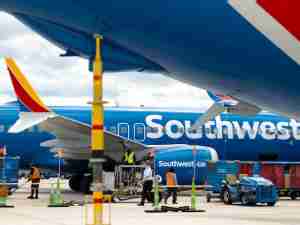Southwest Airlines Co. said it expects to post a loss in the first quarter and then resume logging profits as it navigates the omicron coronavirus variant’s impact on a fledgling air-travel recovery.
The airline trimmed first-quarter flying capacity to 9% below pre-pandemic levels and nearly doubled its estimate for a rise in nonfuel costs, Southwest said in a statement Thursday as it disclosed fourth-quarter financial results. The guidance contrasts with the optimistic outlook offered just last month, when the Dallas-based carrier said it expected a profit in every quarter of 2022.
“The omicron variant has delayed the demand improvement we were previously expecting in early 2022,” Bob Jordan, who will take over for Chief Executive Officer Gary Kelly on Feb. 1, said in the statement. “With Covid-19 cases trending downward, the worst appears to be behind us, and we are optimistic about current bookings and revenue trends for March 2022.”
The omicron surge has prompted some companies to extend work-from-home programs, postponing a much-needed return of corporate demand during what’s normally the slowest travel period for airlines. The virus also has hit airline flight crews and others, leading Southwest to extend incentive pay for extra work through early February. Separately, Southwest said it plans to boost its starting wage to $17 an hour to attract more new employees.
Other carriers have said the variant could slow the industry rebound for as much as 90 days. Omicron, along with foul weather and other factors, have led Southwest to cancel 7% of flights since the start of January, according to data from FlightAware.com.
Southwest shares rose 1.4% at 10:19 a.m. in New York amid a broad market rally and was the second-worst performer in Standard & Poor’s broad airline industry index. The stock fell 4.6% over the 12 months through Wednesday.
Southwest reported a fourth-quarter adjusted profit of 14 cents a share, compared with the 12-cent average of analysts’ estimates compiled by Bloomberg. Revenue of $5.05 billion was roughly in line with the $5.06 billion expected by Wall Street.
The quarterly profit was the airline’s first excluding federal aid since the start of the pandemic. Southwest expects to lose money in January and February before returning to a profit in the final month of the quarter. Costs to fly each seat a mile will soar to as much as 24% above the same level in 2019, compared with an earlier forecast for as much as 14%.
“We’re really anticipating some unit-cost pressures in 2022, and it likely is going to take us through 2023 to get back to our fighting weight on the cost structure,” Kelly said in an interview.
Unit costs, a gauge of efficiency, will rise in part on plans to add 8,000 jobs this year after hiring more than 5,000 in 2021, the extended overtime pay and the increase in minimum wages that Southwest said it’s discussing with unions. The airline boosted starting pay to $15 an hour on Aug. 1 as it faced competition from other industries to hire entry-level workers.
The increase to $17 comes as Southwest struggles to find enough employees as it competes to fill entry-level jobs with companies such as Amazon.com Inc. and Walmart Inc.
“The market is very competitive and it’s becoming even more competitive,” Jordan said.
Rising Costs
Full-year unit costs will rise as much as 16%, compared with a December outlook for growth of up to 12%.
Southwest said 5,000 employees became ill with omicron in the first three weeks of January as cases spread rapidly. The resulting incentive pay and canceled flights as crew illnesses increased accounted for most of the higher costs and increased unit cost outlook, Jordan said.
With flying capacity across airlines still largely below 2019, rising costs are becoming a bigger concern, with the four largest U.S. airlines each projecting as much as a double-digit rise in non-fuel operating expenses. Southwest’s new first-quarter capacity outlook compares to a prior plan for 6% below pre-pandemic levels. The carrier said it would slow growth for the first half of 2022, trimming capacity for the full year to 4% below 2019. An earlier outlook called for as much as a 2% rise.









